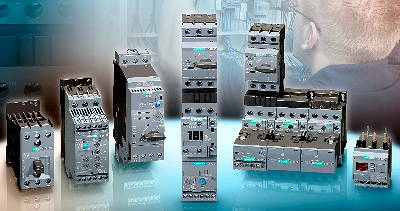![]() At the recent SPS/IPC/Drives exhibition in Germany, Siemens unveiled a new generation of its Sirius modular motor control gear system which packs more functions into smaller, easier-to-assemble modules. The company says that the new products will save space, cut wiring costs, make assembly easier and provide more diagnostic information.
At the recent SPS/IPC/Drives exhibition in Germany, Siemens unveiled a new generation of its Sirius modular motor control gear system which packs more functions into smaller, easier-to-assemble modules. The company says that the new products will save space, cut wiring costs, make assembly easier and provide more diagnostic information.
“We’ve taken a huge step forward,” declared Eckard Eberle, head of Siemens’ control components business, at the launch. “Innovation like this happens only once a decade.”

Initially, the new system (shown above) covers currents up to 40A in two frame sizes for both main and control circuits: S00 for applications up to 7.5kW; and S0 up to 18.5kW, at 400V. The contactors up to 38A and circuit-breakers up to 40A are just 45mm wide. The system also includes the 3RW30 and 3RW40 soft-starters and the 3RA6 compact starter launched in 2008.
To assemble direct starters, reversing starters or star-delta starters, users no longer need to get involved in costly wiring. They simply plug the appropriate function modules into a contactor, thus avoiding installation errors.
The function module for a direct starter has integrated on and off delay timing relays, while the star-delta module contains the control logic and the time setting, thus avoiding the need for conventional auxiliary switches, timer relays and control circuit wiring. The modules fit both contactor frame sizes and their wide voltage capability is said to allow them to be used with any motor.
The circuit breakers, load feeders or compact starters are supplied with power simply by clicking them into an infeed system.
Two- and three-phase current monitoring relays are integrated into the load feeders, allowing not only the motor, but also the entire application, to be monitored directly from the feeder. The relays can monitor all connected parts of a system for overcurrents, undercurrents, cable breaks and phase failures. Motor overloads or load shedding can be detected early, allowing a PLC to shut down the system before a motor circuit-breaker cuts off an entire feeder.
The Sirius contactors connect to PLCs via AS-i or IO-Link communications modules that click onto them, avoiding the need for parallel wiring to the controller. Because the components are integrated into Siemens’ Step 7 engineering system, all of the load feeder data is available to the controller.
Previously unavailable diagnostics information such as operating modes, limit positions and device defects, can be pre-processed via IO-Link without needing any configuration. This allows faults to be located immediately and displayed centrally, or via local HMI displays, so they can be rectified rapidly. This ability to provide plant-wide diagnostics down to the field level simplifies plant monitoring and maintenance.
The Sirius components are said to use up to 10% less energy than their predecessors. Novel contact materials reduce main-circuit contact resistance, while electronic controls in the contactor coils reduce heat inside control cabinets. Eberle says that the higher power density of the switching devices will allow them to handle tasks that previously needed larger devices, and will reduce the need for air-conditioning and the size of power supplies.
A spring-loaded connection system that resists bumps and vibration is available for all components in the new Sirius system. A plug-in connection interface enables tool-free assembly of direct starters, reversing starters or star-delta starters. All of the components are also available with screw and ring tongue terminals.
Eberle predicts that the new Sirius system will deliver greater speed and efficiency for machine and control panel builders, as well as simplifying their planning and configuration work. “For the end-user,” he adds, “we are avoiding the risk of error and increasing plant availability, whilst also reducing operating costs.”




